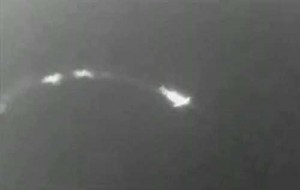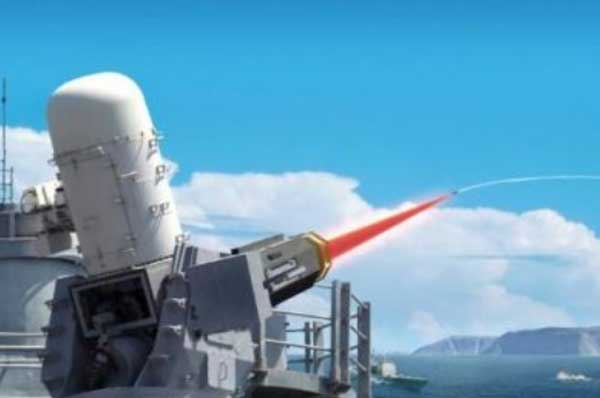
A major attraction-getter at the recent Farnborough International Air Show, the biennial aviation event in southern England at which representatives from SLD attended, was a video displaying a laser weapon downing four unmanned aerial vehicles flying over the water. The tests represented the first time that a ship-based solid-state laser has shot down an aircraft mid-flight over water. The Boeing Corporation has already used directed energy weapons deployed on land to shoot down UAVs, but achieving the same success from the deck of a ship—which is moving in multiple directions due to vessel’s motion, the ocean waves and other disturbances—is much more challenging.
This Laser Weapon System (LaWS) was developed by the Raytheon Corporation to take advantage of the sensors on the company’s Phalanx Close-in Weapon System. The LaWS upgrades the traditional ship- and land-based MK 15 Phalanx, a multi-barreled 20mm rapid-fire Gatling gun that is already widely deployed on U.S. Navy ships, by adding a combined-beam fiber laser, rated at 50 kilowatts, to supplement the Phalanx’s traditional kinetic projectiles with non-kinetic laser bursts.
The video depicts events this May. The U.S. Naval Sea Systems Command employed the LaWS-Phalanx combination to destroy four UAVs in over-the-water experiments at the Navy’s test range on San Nicolas Island off the coast of California. Previous Raytheon tests had been against static land targets. The Navy-Raytheon team used the Phalanx’s sensors first to track the targets, which included a drone traveling at about 300mph at a distance of more than two miles. Then the LaWS destroyed the UAVs using six off-the-shelf commercial lasers Raytheon had acquired from the car industry. The Phalanx sophisticated electronics concentrated the six lasers into a single powerful beam that soon set fire to the underside of the drones, causing them to spin out of control and crash.
These directed-energy weapons (DEWs) destroy targets by transferring a concentrated beam of energy to the target. DEWs like lasers have a number of advantages over traditional projectile weapons such as missiles. For instance, since a laser beam travels at the speed of light, there is no need to compensate for target movement. The lack of a kinetic effect also allows for more precise targeting, which can minimize collateral damage as compared with the blast impact of conventional weapons or the radiation and other contaminants that can result from the use of weapons of mass destruction.
The Navy has been experimenting with the LaWS-Phalanx combination and other laser prototypes in recent years in the hopes of deploying them with operational units in the next few years. The LaWS is a solid-state rather than a chemical laser. As a result, it requires less energy to operate and is somewhat safer and smaller. Its weaker beam still proved sufficient to set the underside of the UAVs on fire despite the moist air over the oceans, which can more readily absorb and deflect laser beams. The weapon is also supposedly sufficiently powerful to work even in the rain.
The Navy’s Laser Weapon System (Credit Photo: Defence Talk)
The Navy expects eventually to deploy DEWs on most of its large warships, though as a complement rather than substitute for existing kinetic weapons, which will probably remain more effective at attacking faster manned warplanes as well as ground-based targets. It is perhaps unsurprising that the Navy has taken a lead role in preparing to integrate lasers with its operational units. The Navy sees rapid-fire directed energy weapons such as lasers as especially useful in countering the growing threat of anti-ship missiles, high-speed small boat attacks, and other emerging maritime attack systems that potential adversaries such as Iran and China could use for area-denial operations.
Although lasers were invented shortly after World War II, their primary use in battle thus far has been as a means of targeting, communications, and other non-lethal applications where they have had to rely on kinetic methods for destroying their target. U.S. government funding for research on laser-based weapons rose considerably after 1983, when President Ronald Reagan launched his Strategic Defense Initiative to develop and deploy a comprehensive anti-missile defense system capable of protecting the United States and its allies from even the mighty Soviet missile arsenal. Unfortunately, at that time, much of DEW research was in its infancy, leading to growing impatience about the absence of operational systems despite the long-term nature and high costs of these research and development program.
The main problems with moving DEWs from the laboratory to operational use have been their enormous energy requirements, the high temperatures they produce, and their delicate construction and maintenance. Modern Navy ships have enormous power-generation capacity, readily available coolant in the form of water, and typically sail with skilled maintenance crews in charge of well-integrated combat, communications, logistics, and other integrated systems. Still, the LaWS can be placed in a mobile trailer to operate at land, and other ship-based DEWS should also be operable from the ground.
One goal of current Navy DEW develop programs is to be able to integrate any ship-born laser into a vessel’s existing weapons systems so that it will not require a separate command and control suites. For example, the LaWS can leverage the Navy’s existing investment in the Phalanx Close-in Weapon system by using the Phalanx’s sensor suite. Such integration will also help contain costs, which could pose a greater barrier than the technical impediments to the widespread use of the lasers on Navy ships in the next few years. Defense experts note that, after buying DEWs, the Navy would need fewer kinetic projectiles. The relative costs to mating newly developed DEWs with already available ships and crews might also be relatively small given the magnitude of the expense of building and maintaining a modern warship. In any case, losing a warship to an adversary due to foregone defensive weapons technologies would entail a multi-billion dollar ship replacement cost, along with the potential loss of priceless military personnel.
In contrast, the Air Force is still willing to work with the U.S. Missile Defense Agency (MDA) and expend large sums of money in the hopes of developing an air-mobile laser sufficiently powerful and accurate to be able to destroy ballistic missiles in flight. Despite continued delays and other problems, the Airborne Laser Test Bed (ALTB) is currently being developed as an advanced platform for the U.S. ballistic missile defense program (see for example SLD’s video on the ALTB or SLD’s interview about the ALTB). The ALTB aims to demonstrate the potential of using directed energy as a viable technology against ballistic missiles. At present, the main test bed carries a High Energy Laser on a significantly modified Boeing 747-400 Freighter. After being assembled in 2000 and arriving in Wichita, Kansas, the ALTB completed its maiden flight on January 22, 2002. The main weapon, a Chemical Oxygen Iodine Laser (COIL), was first tested on November 12, 2004 at Edwards Air Force Base, when all six modules successfully fired. The ALTB aircraft achieved flight certification in April 2009, meaning that the laser was successfully integrated with the aircraft. The Laser itself uses six infrared sensors to detect the exhaust plume of a boosting missile. Once a target is detected, a solid-state laser tracks the missile and determines a precise aim point. The Beacon Illuminator measures the disturbances in the atmosphere to accurately point and focus the Laser. Then a fire control system focuses the megawatt-class COIL beam onto a pressurized area of the missile, remaining focused on that point until the concentrated energy causes the missile to fail.
The ALTB COIL has achieved some limited successes in testing. On August 10, 2009, the aircraft successfully acquired, tracked, and simulated the low-power direct energy kill sequences against an instrumentally boosting target. On January 10, 2010, the aircraft ALTB successfully engaged an instrumental rocket. Another test was conducted on February 11, 2010, when the ALTB successfully engaged—e.g. detected, tracked, “compensated for atmospheric disturbances” and destroyed—a short-range ballistic missile launched from an at-sea mobile launch platform. The entire engagement occurred within two minutes of the target launch. This was the first directed energy lethal intercept demonstrated against a liquid-fuel boosting ballistic missile target from an airborne platform. On February 3, the ALTB destroyed a solid fuel missile. According to the MDA, the “revolutionary use of directed energy is very attractive for missile defense with the potential to attack multiple targets at the speed of light, at a range of hundreds kilometers, and at a low cost per intercept attempt compared to current technologies.” The Vice Chairman of Boeing’s Missile Defense Systems, Greg Hyslop, boasted that “the government-industry team has produced a breakthrough with incredible potential.”

On June 23, 2010, Boeing announced that it is combining its ALTB and Directed Energy organizations into a single Directed Energy Systems team based in Albuquerque. Boeing’s most active energy program projects are with the three main U.S. Military Services. These are more modest than the company’s high-profile efforts to develop a laser suitable for ballistic missile defense, but more likely to yield concrete results in the short term. The U.S. Army is funding Boeing’s High Laser Technology Demonstrator (HEL TD), a mounted beam control system aimed at countering short-range rocket, artillery, and mortar projectiles. The U.S. Air Force is sponsoring the Tactical Relay Mirror System (TRMS) designed to enhance laser-based systems by extending their range beyond line-of-sight attacks. The U.S. Navy-funded Free Electron Laser (FEL) aims to counter threats from hyper-velocity cruise missiles, such as those under development in China, India, and Russia. Boeing is also using internal funds to support research and development projects the company’s managers believe hold promise for helping the Department of Defense meet core needs. A Humvee-based Laser Avenger system, for example, seeks to destroy improvised explosive devises IEDs), unexploded ordinance, and UAVs. During December 2008 testing, a Laser Avenger engaged and destroyed a small UAV from an operationally relevant range, marking the first time a combat vehicle has used a laser to shoot down a drone. Laser Avenger destroyed another UAV and 50 IEDs in separate 2009 tests.
According to the MDA, there are no present plans to build additional ALTB aircraft. The 2010 National Defense Authorization Act (S. 1390) canceled a planned second laser and refocused the Airborne Laser program as a technology research effort. Accordingly, its budget was reduced from $401.2 million to some $186.7 million in 2010. At a press conference in June 2009, Defense Secretary Robert Gates said that, “We’re keeping the first one, but the operational concept doesn’t work because to be of any value, for example against Iran, that 747 would have to orbit inside Iran. Don’t think they’re going to allow that. Same way with North Korea. So we want to continue that directed energy research, that’s why we’re keeping the first airborne laser.” In May 2010, at a House Strategic Forces Subcommittee Hearing, Chairman James R. Langevin argued that directed energy research should facilitate the testing and development of technologies that are most likely to yield operational capabilities in the future. According to the GAO 2010 Defense Acquisitions report, none of the ALTB’s critical technologies are fully mature. Some $98.7 million were requested for DEW research for 2011. Systems the Pentagon considered more developed or promising have received proposed finding boosts. These included the midcourse missile defense systems, such as the AEGIS system.
At the present, DEWs hold more promise as systems to in intercept short-range projectiles like rockets, UAVs, and small ships located in their vicinity. There are recurring proposals to deploy a tactical DEW system in Israel to deal with Hamas rocket attacks. A joint U.S.-Israeli effort produced a prototype tactical laser that in tests destroyed 46 rockets, artillery shells and mortar rounds in flight. Tactical DEW could also help protect Kabul, Baghdad, and other urban areas or military bases that come under sustained bombardment from short-range rockets. Tactical DEW systems could also be located at high-profile events, such as G-8/20 summits, to add another layer of security.
The Raytheon LaWS is a good example of continuing American strengths in this area, but the British and Indian governments have recently announced their own DEW R&D efforts. Given the limited nature of UK defense resources, a constraint highlighted by British officials at the Farnborough Air Show, perhaps a NATO-wide research, development, and deployment program would be appropriate for some DEW systems. After all, the Phalanx is deployed on many British and other NATO warships in addition to its widespread presence in the U.S. fleet.
———-
*** Posted On August 8th, 2010


